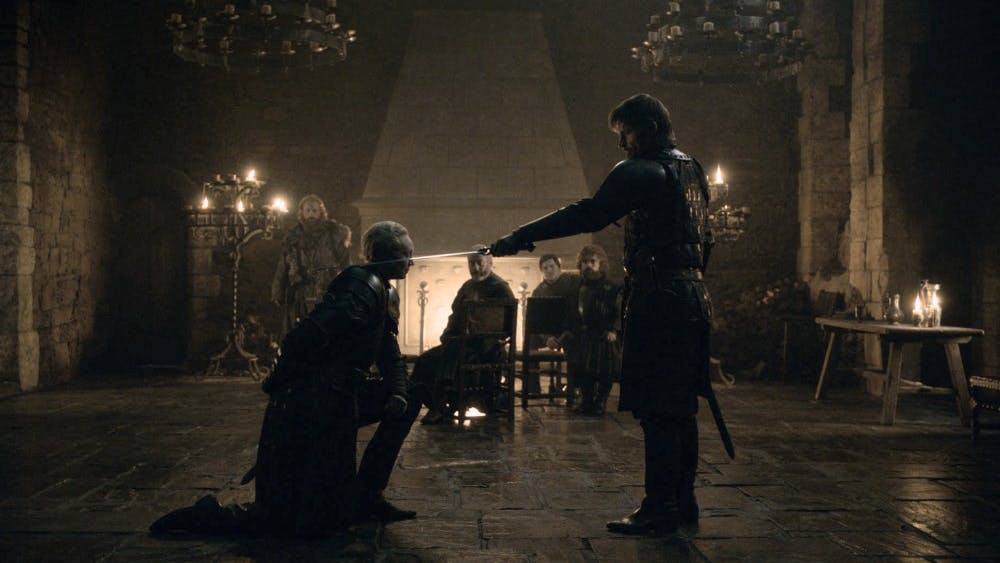As the audience takes their seats, the curtain opens to a bleak setting, analogous to the rural Irish countryside which is the County Longford setting of the performance. A man, or rather a goat, paces back-and-forth bleating. He holds his hands like cloven-hooves. Slow Moving Clouds, the live accompanying trio, tunes their instrument. Three cinder blocks and a rope hold the man to center stage, he wears nothing besides undergarments and glasses. The actors surround the stage. A man wearing a black jumpsuit and beanie lights a cigarette, sitting in a chair at stage right. A disheveled, gray-haired woman sits in a wheelchair on stage left. Three upright a-frame ladders surround perimeter of the stage, accompanied by three female dancers in white dresses.
When the lights dim, the nyckelharpa and cello sit silent as the fiddle begins, played by Irish traditional music master, Danny Diamond. They sit on a bare platform behind the goat as the score begins, haunting, pensive and dissonant. From the audience come forth three men, or "Watchers", dressed in black jackets, black pants, white shirts and wide brimmed black hats, attire not dissimilar to that worn by men of the Amish faith. This is mostly likely a reference to the dark legend of the "Shadow Hat-Man". The three men have their eyes focused on the goat in center-stage, played by actor Mikel Murfi. They begin a ritual-like dance, they outstretch and retract their arms. As they cross their feet and circle the goat, they come closer to the cinder blocks the goat stands atop. The goat stands bleating in fear on the blocks. The men make the goat their captive and bring it to the ground. They douse the goat in water and cleanse it in red towels.
The actions seem relative to those of a baptism and even more so to a ritual sacrifice. In the former interpretation, it is apparent the water is holy water. The goat is dressed by the watchers and becomes a man. He sits in a chair behind a table in center stage and is given a cigarette and tea. The following performance is narrated by this man, the Holy Man, and the events of the plot begin.
From the start of the performance, it becomes apparent that much of the symbolism is Christian in nature. The evil symbol of the goat has its sins washed away in baptism only to become a holy man, or priest, a powerful figure in the rural setting. In the program notes for the performance all that is provided of the performance is a quote from the writer/director/choreographer Michael Keegan-Dolan which includes the following, "Much of Christian culture has been reduced to a simple notion that God is good, has a white beard and lives in the light, and the devil is bad and sits in the dark. This reductive view of the nature of things can be the root of much suffering and confusion." This transfiguration of a goat, a symbol of evil, into a priest, a symbol of good, identifies this false-dichotomy in the opening scene.
As the plot develops it becomes apparent that the Watchers symbolize enablers of abuse in this modern Irish setting: the Roman Catholic church, the police (Garda Síochaná) and the government. Later in the performance, the priest further transfigures into politician, then to police chief and then to priest.
The performance follows the period of life of the protagonist, Jimmy O'Reilly from shortly prior to his 36th birthday, a year following the death of his father, until his early death in what might be interpreted as a "suicide-by-cop.” Jimmy is a troubled man who has been afflicted with depression since the death of his father. His mother plans to rebuild his family home which Jimmy finds hard to face as he still lives with her. The home which has existed in his family for 300 years. At the same time, his elderly mother implores Jimmy to find a wife.
As the life of Jimmy O'Reilly unravels, the story of the Holy Man is told. The powerful man of the parish is revealed to have sexually assaulted one his students, Finola, of the all-girls Catholic school where he instructs class. When the act is witnessed by Finola’s three younger sisters, he threatens to turn all four girls to beasts. Later that night, when Finola screams to her mother of what happened to her, she has no tongue, she has transformed to swan. This sequence of events allude to the Irish tale of the Children of Lir, in which the protagonist Finola and her three siblings are changed from humans into animals by an evil figure. When Finola and her siblings are transformed into swans, they meet Jimmy O'Reilly at the edge of Swan Lake as he attempts suicide.
When Finola meets Jimmy, they engage each other. Finola swoops in to knock the shotgun from his hands at first but they eventually join each other in a pas de deux. Slow Moving Clouds plays a moving interpretation of the traditional Finnish song "Hiljainen Suru" during the scene, the translation of which is "Quiet Sadness.” The suffering of both Jimmy and Finola is tangible in just the melancholy of the song, regardless of the lyrics. This scene alone can bring any member of the audience to tears. From then forth the performance builds up to Jimmy's eventual death and the final, cathartic scene which acts as an analogy to an Irish wake, the celebration of one's life after their passing.
As a final word, I will leave you with a quote from the writer Michael Keegan-Dolan on Loch na hEala, "When depression visits us it's asking us to change. Depression by its nature forces you to be still long enough to hear what you are telling yourself. . . When our senses have nothing on which to attach, our internal world wakes up and starts to speak to us quietly. When this happens, it is important to listen carefully."










